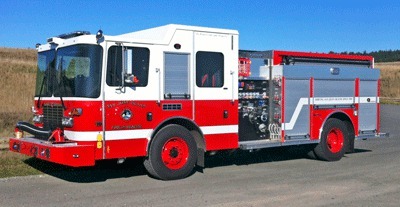By Sheila Harley, San Juan Fire & Rescue public information officer
Six new engines are all here and ready to go.
Actually, they have been in service for several months. They are replacing the fire engines that have protected us for 30 years.
San Juan Island Fire Rescue purchased your new engines from General Fire Equipment in Spokane, Wash. Not only did we get a good deal, but we also were able to arrange the sale so that much of the sales tax revenue stayed local.
The new engines should serve the community for at least 25 years. The fire district paid about $350,000 per engine (That’s about $50,000 less than most communities pay for a fire engine.)
The engines are island specific. In other words, they were designed with our island’s particular needs in mind. They provide much better driver sight, thereby providing more safety for the crew aboard. The crew all face forward providing safety and much better communication between them.
The retiring engines had firefighters sitting facing backwards and exposed to the elements. The new engines carry 25 percent more water than the old engines, which is important when fighting fires in areas not covered by fire hydrants (a good deal of the island).
The new engines can draft water from a special fitting on the front, making it easier and faster for the crew when they need to get water from a pond. This alleviates, in some cases, the possibility of not having enough water at the scene of a fire and requires fewer firefighters leaving the scene to find a water supply, thereby allowing more people stay on the scene to fight the fire.
The new engines provide their own electricity for lighting up a scene, which also leaves more firefighters available to do their job and eliminates the need of a generator in most cases.
Like all new vehicles, these engines require training by each firefighter—a minimal 20 hours. Each engine is identical to the others, however, which streamlines training and maintenance.
If you look above the cab door of each fire engine you will see our motto printed there: “To Save Lives and Protect Property.”
What happens to the old engines? Good question.
Two are going to Shaw Island to augment their fire-fighting capabilities. One of those two will become a shared reserved engine for the entire county, which is another insurance industry requirement.
General Fire Equipment took the other engine as “trade in” and then generously donated it to Shaw Island Fire and Rescue. Another engine has been sold to a small town in the Sierra Nevada Mountains, in California.
Two engines have been sold to a group that sends fire apparatus to communities in Mexico that desperately need equipment. So, our old engines are giving further service to places not as fortunate in their own fire-fighting capabilities.
This entire project was driven by a need to protect property owners’ insurance rates. The insurance industry penalizes a community when the apparatus that protects it is more that 10 years old, even if fire engines are very well maintained—as our previous engines were.
Even though the new engines are a substantial investment, the board of fire commissioners was able to find a way to purchase them without asking the community to pay any additional taxes.
Come by Station 31, on Mullis Street, and take a look. We are always glad to see you. We’re also always ready to welcome people who are willing to volunteer their time to protect our great community.
— Chief Steve Marler contributed to this report



